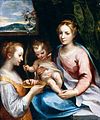Francesco Vanni

Francesco Vanni (1563 – 26 October 1610) was an Italian painter active in Rome and his native city of Siena.
Biography
Vanni was part of a family of painters, including his half-brother Ventura Salimbeni and stepfather Arcangelo Salimbeni, the latter of whom died when Francesco was young. As a 16-year-old, Vanni went first to Bologna, then to Rome. He apprenticed with Giovanni de' Vecchi during 1579–80, also being influenced, like other Tuscan painters of his day, by Federico Barocci from Urbino. Vanni was among the last painters who reflected the influence of the Sienese School of painting. He was named a Cavalieri.
In Rome, he worked later with Salimbeni, Bartolomeo Passerotti, and Andrea Lilio. He was commissioned by Pope Clement VIII to paint an altarpiece for the St. Peter's, later transferred to mosaic, Simon Magus rebuked by St. Peter. He painted several other pictures for Roman churches; including St Michael defeats rebel angels for the sacristy of S. Gregorio; a Pietà for Santa Maria in Vallicella; and the Assumption for San Lorenzo in Miranda.
Returning to Siena, where he ultimately died, he afterwards worked at Parma, Bologna, and again at Rome. At Siena, he painted a S. Raimondo walking on the Sea for the church of the Dominicans. Vanni painted a Baptism of Constantine (1586–87) for the church of San Agostino in Siena. He painted a Christ appearing to St. Catherine for the chapel of il Refugio at the Sanctuary of Santa Caterina di Siena, and a Baptism (1587) for the former church of San Giovannino e Gennaro, Siena. He painted an Immaculate Conception (1588) for the Montalcino Cathedral and an Annunciation (1589) for the church of Santa Maria dei Servi in Siena. He painted a "Crucifixion with Father Matteo Guerra" for San Giorgio. One of his pupils was Rutilio Manetti.[1]
His sons, Michelangelo and Raffaello Vanni were also painters. Among his pupils was Astolfo Petrazzi.[2] The painter from Perugia, Benedetto Bandieri, claimed to be a descendant of Vanni.[3]
The painter Francesco di Vanni was active in the 14th century.
Gallery
-
Flagellation of Christ, Kunsthistorisches Museum, Vienna
-
Madonna and Child with St. Lucy
-
Sacra Famiglia
References
- Bryan, Michael (1889). Walter Armstrong & Robert Edmund Graves (ed.). Dictionary of Painters and Engravers, Biographical and Critical (Volume II L-Z). York St. #4, Covent Garden, London; Original from Fogg Library, Digitized May 18, 2007: George Bell and Sons. p. 632.
{{cite book}}: CS1 maint: location (link) - Web gallery of art biography.
- Short biography.
- Domenico Sedini, Francesco Vanni, online catalogue Artgate by Fondazione Cariplo, 2010, CC BY-SA.
- ^ Getty ULAN entry
- ^ Orlandi, Pellegrino Antonio; Guarienti, Pietro (1719), Abecedario pittorico, Naples, p. 437
- ^ Orlandi, page 87.
Other projects
![]() Media related to Francesco Vanni at Wikimedia Commons
Media related to Francesco Vanni at Wikimedia Commons



